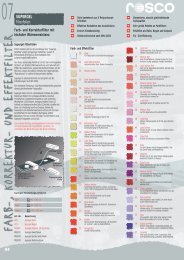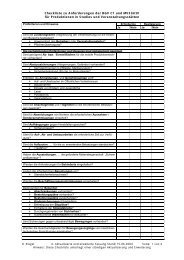Lighting the Acting Areas - AudioMaster
Lighting the Acting Areas - AudioMaster
Lighting the Acting Areas - AudioMaster
Create successful ePaper yourself
Turn your PDF publications into a flip-book with our unique Google optimized e-Paper software.
Manufacturing High Temperature Colour Filter<br />
A colour filter combines light refracting elements, normally organic dyes, which are suspended in or coated on a transparent base. Rosco began<br />
producing gelatin filters in 1910, but since <strong>the</strong> 1950s, colour filters have been fabricated on plastic bases. Polycarbonate, <strong>the</strong> base used for <strong>the</strong><br />
Supergel range, is <strong>the</strong> most durable of <strong>the</strong> polymers currently utilized.<br />
There are three methods currently employed to integrate dyes with polymer bases in order to create colour filters. The products are described as:<br />
• Surface Coated<br />
• Deep Dyed<br />
• Body Coloured<br />
Surface Coated Polyester - (Rosco E-Colour+, Lee Filter)<br />
Optically clear polyester film (PET) is coated with a flame retardant and dye solution on one or two<br />
sides to a precisely controlled thickness. The carrier solvent is baked off leaving a stable coating<br />
bonded to <strong>the</strong> substrate. Advanced dye technology gives good resistance to dye fade in hot lights.<br />
Deep-Dyed Polyester - (Roscolux, Cinegel and GAM Filter)<br />
Like surface coated PET, deep dyed film begins with a roll of clear polyester. The film is passed<br />
through a bath of heated solvent suffused with dye. The solvent causes <strong>the</strong> PET film to swell<br />
expanding <strong>the</strong> polymer structure of <strong>the</strong> film and allowing <strong>the</strong> dye molecules to penetrate <strong>the</strong> surface.<br />
The film is <strong>the</strong>n washed and <strong>the</strong> polymer contracts to its normal form, trapping <strong>the</strong> dye molecules<br />
below <strong>the</strong> surface.<br />
Deep-dyed filters tend to be slightly more resistant to fading than surface coated filters.<br />
Body-Coloured Polycarbonate - (Supergel)<br />
In a body-coloured colour filter like Supergel <strong>the</strong> colour is inherent within <strong>the</strong> plastic substrate.<br />
Powdered resin and dye is mixed under intense pressure and heat of over 300°C and <strong>the</strong> mixture is<br />
extruded through a die to form a coloured core of film. In Rosco’s co-extrusion process fur<strong>the</strong>r<br />
extruders seal this core in between two more layers of clear polycarbonate. This locked-in colour,<br />
combined with <strong>the</strong> high temperature resistant polycarbonate gives very high heat withstand to colour<br />
filter even in very hot lighting instruments.<br />
It is possible to coat polycarbonate film, but <strong>the</strong> Rosco system eliminates ‘stress’ orientation which may<br />
occur in coated filter – which means in hot spotlights and scrollers if <strong>the</strong> filter buckles or shrinks <strong>the</strong>re<br />
are serious problems; indeed scrollers should be fitted with Supergel colour, for safety’s sake.<br />
Flame Retardance in Colour Filters<br />
All Rosco colour filters comply with current regulations for flame retardance, in <strong>the</strong> UK, this is:<br />
BS3944 pt1: 1992.<br />
Supergel, by virtue of <strong>the</strong> polycarbonate base and state-of-<strong>the</strong>-art technology, also is certificated:<br />
France M1<br />
Germany B1 (DIN 4102-01)<br />
Austria MA39<br />
Italy C1 and<br />
Shown here is a cross section of co-extruded Rosco Supergel filter<br />
Spain M2.<br />
photographed through an electron microscope. Note <strong>the</strong> discrete clear<br />
layers on <strong>the</strong> top and bottom sealing in <strong>the</strong> colour core.<br />
| 5






